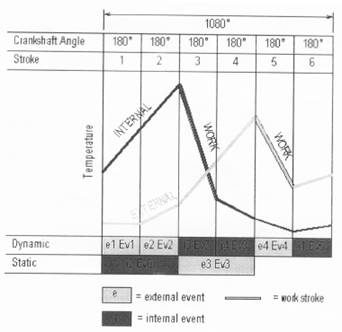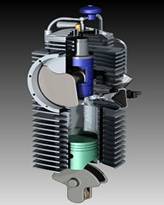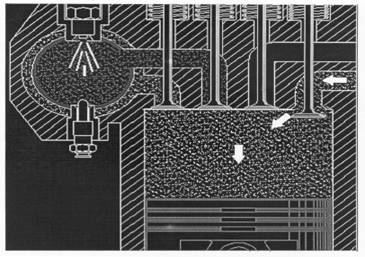





Published on Apr 02, 2024
Six Stroke engine, the name itself indicates a cycle of six strokes out of which two are useful power strokes. According to its mechanical design, the six-stroke engine with external and internal combustion and double flow is similar to the actual internal reciprocating combustion engine.
However, it differentiates itself entirely, due to its thermodynamic cycle and a modified cylinder head with two supplementary chambers: combustion and an air heating chamber, both independent from the cylinder. In this the cylinder and the combustion chamber are separated which gives more freedom for design analysis. Several advantages result from this, one very important being the increase in thermal efficiency. It consists of two cycles of operations namely external combustion cycle and internal combustion cycle, each cycle having four events. In addition to the two valves in the four stroke engine two more valves are incorporated which are operated by a piston arrangement.
The Six Stroke is thermodynamically more efficient because the change in volume of the power stroke is greater than the intake stroke and the compression stroke. The main advantages of six stroke engine includes reduction in fuel consumption by 40%, two power strokes in the six stroke cycle, dramatic reduction in pollution, adaptability to multi fuel operation. Six stroke engine's adoption by the automobile industry would have a tremendous impact on the environment and world economy.

Six-stroke engine is mainly due to the radical hybridization of two- and four-stroke technology. The six-stroke engine is supplemented with two chambers, which allow parallel function and results a full eight-event cycle: two four-event-each cycles, an external combustion cycle and an internal combustion cycle. In the internal combustion there is direct contact between air and the working fluid, whereas there is no direct contact between air and the working fluid in the external combustion process. Those events that affect the motion of the crankshaft are called dynamic events and those, which do not effect are called static events.
The sketches shows the cylinder head equipped with both chambers and four valves of which two are conventional (intake and exhaust). The two others are made of heavy-duty heat-resisting material. During the combustion and the air heating processes, the valves could open under the pressure within the chambers. To avoid this, a piston is installed on both valve shafts which compensate this pressure. Being a six-stroke cycle, the camshaft speed in one third of the crankshaft speed.


The combustion chambers walls are glowing when the engine is running. Their small thickness allows heat exchange with the air-heating chamber, which is surrounding the combustion chamber. The air-heating chamber is isolated from the cylinder head to reduce thermal loss.
The combustion and air-heating chambers have different compression ratio. The compression ratio is high for the heating chamber, which operates on an external cycle and is supplied solely with pure air. On the other hand, the compression ratio is low for the combustion chamber because of effectively increased volumen, which operates on internal combustion cycle.
The combustion of all injected fuel is insured, first, by the supply of preheated pure air in the combustion chamber, then, by the glowing walls of the chamber, which acts as multiple spark plugs. In order to facilitate cold starts, the combustion chamber is fitted with a heater plug (glow plug). In contrast to a diesel engine, which requires a heavy construction, this multi-fuel engine, which can also use diesel fuel, may be built in a much lighter fashion than that of a gas engine, especially in the case of all moving parts.
As well as regulating the intake and exhaust strokes, the valves of the heating and the combustion chambers allow significantly additional adjustments for improving efficiency and reducing noise.
| Are you interested in this topic.Then mail to us immediately to get the full report.
email :- contactv2@gmail.com |